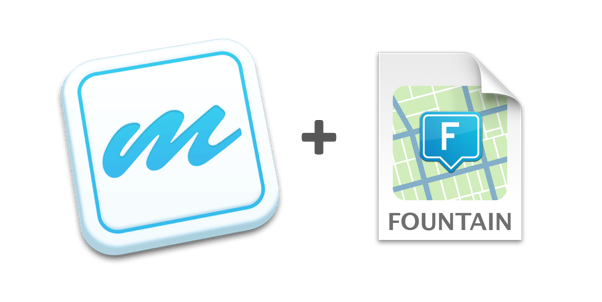Marked 2 and Fountain

Marked 2 and Fountain
Late last night Brett Terpstra unveiled Marked 2. It’s a huge update to one of my favorite Mac apps from one of my favorite Mac people. So, yeah, I’m excited.
I haven’t put it through its paces completely quite yet, but I have done a bit of testing of the biggest new feature (for me, at least) that Brett has long teased: Fountain preview is now built right into Marked. To test it out just open up any .fountain document in it. Brett has added a slew of new tricks that were never possible with the original Fountain for Marked package, like pagination preview and solid print output. And because Brett has good taste Fountain preview defaults to using Courier Prime. Wise choice.
I do want to point out a few differences between the way Fountain in Marked 2 works compared to other apps.1
The first thing is the pagination. Brett’s pagination implementation is very elegant. Any Fountain document opened in Marked 2 will have a continuous scrolling page of text with a thin gray line denoting a page break. To the right of the gray line will be a page number. It gets out of your way but is still visible enough to give you an idea of where you are in your script. Printing will stick to these exact page breaks.
In my minimal testing, I’ve noticed that Marked 2 has slightly different pagination from Slugline and Highland, which both provide identical output. The discrepancy seems to come from the width of action blocks, which are slightly more narrow in Marked 2. As a result some action blocks appear longer, e.g. a four line block spills over to a fifth line.
This is an extremely minor difference, but for now, I’d go with printed output from either Slugline or Highland. That said, pagination is more important for producing a film than writing one; if you just want to write a screenplay then Marked does a bang-up job of previewing formatting for you. Quit whining about page numbers (, Jon,) and write your damn movie.
Marked 2’s Fountain support, out of the box, doesn’t support non-script elements, such as notes, sections and synopses. All of these elements get stripped when the document is opened in Marked. This makes a lot of sense since Marked provides final output preview, however I also think there is some value in seeing inline notes and structure. A toggle to see them would be nice, or at the very least have them parsed so that sections are navigable in the Table of Contents view.
As far as I can tell there are only two bits of the Fountain syntax that are currently unsupported: dual dialogue and centered text. Dual dialogue, I should mention, is technically supported in Marked 2’s built in Fountain parser, however it displays improperly. Try it. I’m sure this will get fixed in an update.
The biggest change I’d like to see to Marked 2’s Fountain implementation is for it to be more customizable. Custom CSS loading gets turned off when you load a .fountain document. If you want to see, say sections and synopses, or you want to turn off bold slug lines in Marked, the only way to do it right now is to load your script with Fountain for Marked. And the only way to do that is to rename your document’s extension to anything other than .fountain. Or keep using the original version of Marked, which is still available and supported.
One other customization niggle is the way Marked 2 loads Courier Prime. The app includes the regular and bold versions of the font, but neither the italic nor the bold italic versions. Italic text is rendered in Marked but it doesn’t load the beautiful italic glyphs designed by Alan Dague-Greene. There is no option to look for the font locally, which would be nice. But I’m weird.
Brett’s Fountain implementation is extremely sophisticated and an excellent addition to the plain text screenwriter’s tool belt. I’ve said nothing of the rest of the advantages Marked 2 has to offer, like deep analysis of word usage, keyword search and readability statistics. There are a million reasons you should go give Brett $12 for his app right now. Fountain is but one of them.
-
I still think it’s nuts that Fountain has an app ecosystem as big as it does these days. ↩︎